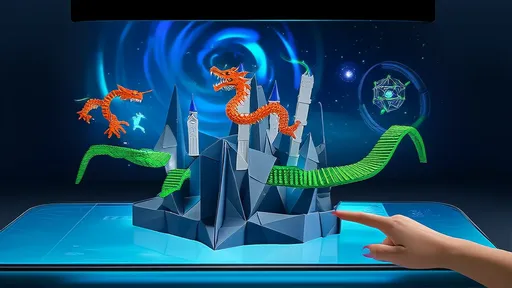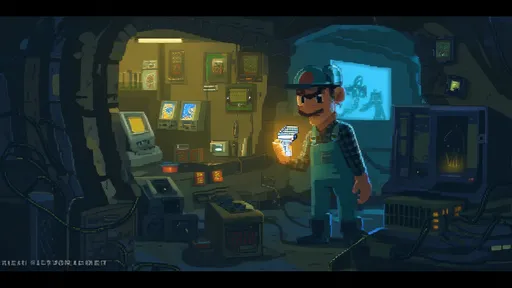The resurgence of tabletop gaming in the digital age is nothing short of a cultural renaissance. Once considered a niche hobby, board games and card games have clawed their way back into mainstream entertainment, thanks in no small part to technological advancements. Among these, augmented reality (AR) has emerged as a game-changer, breathing new life into the tactile pleasure of physical games. What was once a quiet evening of rolling dice and moving tokens has transformed into an immersive experience where the boundaries between the real and virtual worlds blur.
The marriage of AR and tabletop gaming isn’t just a novelty—it’s a revolution. Traditional games, with their cardboard pieces and printed rules, have always had a charm of their own. But AR adds a layer of dynamism that elevates the experience. Imagine a game of chess where the pieces come alive with historical reenactments of famous battles, or a dungeon-crawling adventure where monsters leap off the board and into your living room. This isn’t the future; it’s happening now. Companies like Hasbro and Fantasy Flight Games are already experimenting with AR-enhanced versions of their classics, proving that the physical and digital worlds can coexist harmoniously.
One of the most compelling aspects of AR in tabletop gaming is its ability to democratize complexity. Games like Gloomhaven or Twilight Imperium are notorious for their steep learning curves and lengthy setup times. AR can streamline these processes by overlaying tutorials, automating bookkeeping, and even suggesting strategic moves in real-time. This doesn’t dumb down the experience; instead, it removes the barriers that often prevent newcomers from diving in. The result? A broader, more inclusive community of players who might have otherwise been intimidated by the sheer depth of these games.
But AR’s impact goes beyond accessibility. It also redefines storytelling. Tabletop RPGs like Dungeons & Dragons have always relied on the imagination of players and dungeon masters to bring their worlds to life. AR can enhance this by projecting landscapes, characters, and even weather effects onto the table. Suddenly, the haunted forest your party is traversing isn’t just a description—it’s a visible, interactive environment. The emotional stakes are higher, the immersion deeper, and the memories more vivid. It’s a testament to how technology can amplify, rather than replace, human creativity.
Of course, the integration of AR into tabletop gaming isn’t without its challenges. For one, there’s the issue of cost. High-quality AR devices, like the Microsoft HoloLens or Magic Leap, are still prohibitively expensive for the average consumer. Then there’s the question of design. Not every game benefits from AR, and shoehorning it into classics could feel gimmicky. Developers must strike a delicate balance between innovation and tradition, ensuring that the tech serves the game rather than the other way around.
Despite these hurdles, the potential is undeniable. The tabletop gaming industry is thriving, with annual revenues soaring into the billions. AR represents the next frontier, a way to attract tech-savvy younger audiences without alienating the purists. It’s a delicate dance, but one that could redefine how we play, socialize, and tell stories. The tactile joy of moving pieces, the camaraderie of face-to-face interaction, the thrill of strategy—these are the timeless elements that AR can enhance, not erase.
Looking ahead, the fusion of AR and tabletop gaming is poised to create experiences we’ve only dreamed of. Picture a legacy game where the board evolves not just through stickers and torn cards, but through dynamic, AR-driven narratives that change based on your decisions. Envision educational games where historical events unfold in your classroom, or cooperative puzzles that require physical and digital collaboration. The possibilities are as limitless as the imagination of the designers who dare to explore them.
In the end, AR isn’t here to replace the tangible magic of tabletop gaming. It’s here to expand it. The click of dice, the shuffle of cards, the laughter around the table—these moments are sacred. But with AR, they can also be spectacular. As technology continues to evolve, one thing remains clear: the golden age of tabletop gaming isn’t behind us. It’s just beginning.

By /Jul 3, 2025

By /Jul 3, 2025

By /Jul 3, 2025

By /Jul 3, 2025

By /Jul 3, 2025

By /Jul 3, 2025

By /Jul 3, 2025

By /Jul 3, 2025

By /Jul 3, 2025

By /Jul 3, 2025

By /Jul 3, 2025

By /Jul 3, 2025

By /Jul 3, 2025

By /Jul 3, 2025

By /Jul 3, 2025

By /Jul 3, 2025

By /Jul 3, 2025

By /Jul 3, 2025